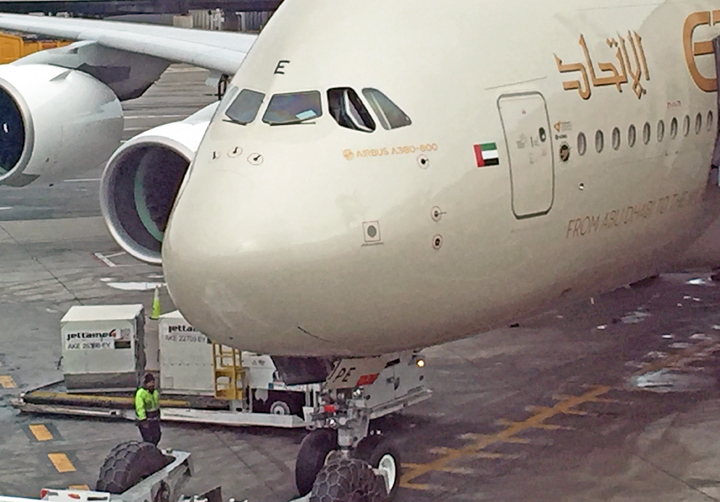When a Wing Comes Apart
February 26, 2024
SO, LAST WEEK, a passenger videoed a damaged wing slat on a United Airlines flight headed from Denver to Boston. Learning of the problem, the crew conferred with its dispatch and maintenance team, and a decision was made to divert the Boeing 757 into Denver.
Copyright issues prevent me from re-posting videos or images, but you can easily Google it. The upper part of the slat, along the front of the wing, inboard of the right engine, appears shredded and chewed. it’s a composite material, and somehow it delaminated and fragmented. How, exactly, is unknown.
Well, no surprise, the pictures are all over media and social media — so much as those things are different nowadays — accompanied by a barrage of terrifying headlines: “Passenger Sees Wing Coming Apart.” “Passenger Horror as Wing Comes Apart.” And so on.
The wing, in fact, did not come part. What “came apart,” if we can call it that, is a portion of a slat. There are several slats per wing, sectioned along the leading edge. Like the trailing-edge flaps along the back of the wing, these devices are deployed in stages to increase lift at low speeds. You’ll see them extended during takeoff and landing, then retracted during cruise.
It’s a terrible look for sure, but the danger here was minimal. One small hazard might’ve been broken material striking the rear stabilizers. Worst case would’ve been the slat breaking apart further, or detaching completely, unlikely as that might be, but even this wouldn’t crash the plane, so long as the stabilizers or tail weren’t struck and badly damaged.
There may have been a discussion about whether or not to deploy the slats for landing. There’s no way to isolate a specific slat, so keeping the broken one retracted would’ve meant a “no flap landing,” where all of the high-lift devices, both flaps and slats, remain stowed. A jetliner can land just fine this way — it just needs to do so at a higher speed, requiring more runway.
A few months ago, due to a malfunction, a 757 I was piloting made a no-flap landing in Colombia. We came in fast, as our checklists dictated (I can’t recall the exact speed), and used about two-thirds of the runway, as our calculations told us to expect. But otherwise the landing was routine. In most ways, what happened to me was more serious than what the United pilots had to deal with, just not as photogenic and so it got no attention.
As it happened, the United pilots deployed the slats and flaps as they normally would, and the plane landed safely. To nobody’s surprise. Certainly not mine.

Segmented slats line the leading edge of a wing, shown here fully retracted. They are operated hydraulically.
I suspect the choice to divert was a practical one as much as anything. Denver is one of United’s biggest hubs, and the plane would need lengthy repairs; grounding it in Boston was going to trigger a cascade of logistical complications affecting hundreds of passengers. In Denver, an airplane swap could be handled expeditiously, with all the needed maintenance resources on site.
Nothing to fret about, all in all. But if the viewer comments on various media sites are any indication, the public is alarmed. “What’s going on in the skies these days?” Asks one reader, his sentiments echoing those of others. “Yet another close call.”
Not really. What’s actually happening is a matter of exposure. These sorts of minor incidents have always been with us. What’s different is the media environment in which they’re occurring. In the old days you never heard about them. Today, everything is photographed and everything is shared. The smallest mishap is on Instagram and other platforms within minutes, visible to millions. A landing gear problem; a compressor stall; a pressurization malfunction. The sky is falling.
Except it’s not. As I’ve talked about in prior articles, major airline disasters are far, far more uncommon today than they used to be. A dearth of them has led to us putting undue focus on relatively harmless incidents instead.
I’m unsure which is more to blame, social media or actual news sources. They seem to feed off one another, so maybe it’s a moot point.
The fact that the 757 is a Boeing model has only made things worse. Thanks to the controversies surrounding the 737 MAX, anything involving a Boeing jet now gets extra scrutiny, deserved or not. No matter that the 757 is a 42 year-old design with an excellent safety record. The B-word is what counts.
Let’s face it, everyone is looking for attention, for views and hits, be it FOX News or the Times or a 16 year-old Instagrammer. Few things, meanwhile, garner more attention or stoke more fear than plane crashes. The mere suggestion of one, realistic or not, is an automatic go-to for eyeballs. And so, here we are.
For more about slats, flaps, and the other doodads than help a plane fly, see chapter one of Cockpit Confidential.
Related Stories:
LUCKY AND GOOD
TWENTY YEARS AND COUNTING
Photos by Asato Hisada, courtesy of Unsplash.






